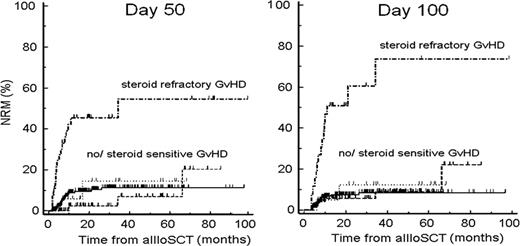Abstract
Abstract 1012
Graft-versus-host disease (GvHD) is the major complication of allogeneic stem cell transplantation (alloSCT) and its therapy-resistant form causes significant morbidity and mortality. The pathomechanism of steroid resistance is currently not completely understood; however, we have recently suggested that endothelial dysfunction seems to play an important role (Luft et al., Blood 2011). The aim of this study was to validate in a large cohort of patients that steroid refractory acute GvHD is associated with endothelial stress. Secondly we assessed if this endothelial stress can be overcome by statins, which are known to have endothelial protective effects.
We have therefore performed a retrospective study of 393 patients who underwent alloSCT in our institution between 2002–2010. Endothelial stress serum markers were correlated with the course of GvHD, non relapse mortality (NRM) and statins intake. Overall, 169 of 393 patients (43%) developed GVHD. Of these, 101 patients (60%) had steroid-sensitive GvHD grade 1–2, 26 patients (15%) steroid-sensitive GvHD grade 3–4 and 42 patients (25%) had steroid-refractory GvHD which was always grade 3–4 at its maximum severity. 224 patients had no signs of GvHD. In order to elucidate the pathomechanisms that contribute to steroid resistance, serum markers of endothelial stress and vascular growth (Angiopoietin-2 (ANG2), IL-8, soluble thrombomodulin (sTM), and vascular endothelial growth factor (VEGF)) were measured by ELISA and multiplex assays before and on days +50 and +100 after alloSCT.
Landmark analyses at days +50 and +100 after alloSCT showed that NRM was dramatically high in the steroid refractory group but was equivalently low in the no GvHD-, sensitive grade 1–2 - and grade 3–4 - groups (p<0.001, Figure 1 ). ANG2, a mediator of endothelial cell vulnerability, measured before transplant was predictive for a steroid refractory course of GvHD (p=0.05) and higher NRM (p=0.06) under the prerequisite that patients developed grade 3–4 GvHD. Moreover, patients who developed an acute steroid refractory GvHD displayed significantly higher levels of the endothelial stress markers IL-8 (day +50: p<0.001; day +100: p<0.001) and sTM (day +50: p<0.009; day +100: p=0.003) compared to steroid-sensitive GvHD patients and patients with no GvHD. High levels of sTM, IL8 and ANG2 were significantly associated with increased NRM rates (day +50: IL8 p=0.02, sTM p=0.0008, ANG2 p=0.0001; day +100: IL8 p=0.0007, sTM p<0.0001, ANG2 p=0.05); even after multivariate adjustment for donor, conditioning intensity, disease status at alloSCT and sex mismatch. In contrast, no influence of VEGF levels on steroid-refractory GvHD.
When IL8, sTM, ANG2 and VEGF kinetics were compared in patients with and without concomitant statin therapy (n=81), no differences were observed in the whole patient cohort nor in the subset with steroid-refractory GVHD. Consequently, patients with or without statins had similar NRM, relapse rates and overall survival in univariate as well as multivariate analysis.
This supports the hypothesis that steroid-refractory GVHD is associated with progressive microangiopathy. Statins, although reported to have protective effects on endothelial cells, were inefficient to alleviate endothelial stress in this context and, accordingly, did not change the outcome of acute GVHD patients.
Luft:Celgene: Research Funding.
Author notes
Asterisk with author names denotes non-ASH members.


This feature is available to Subscribers Only
Sign In or Create an Account Close Modal